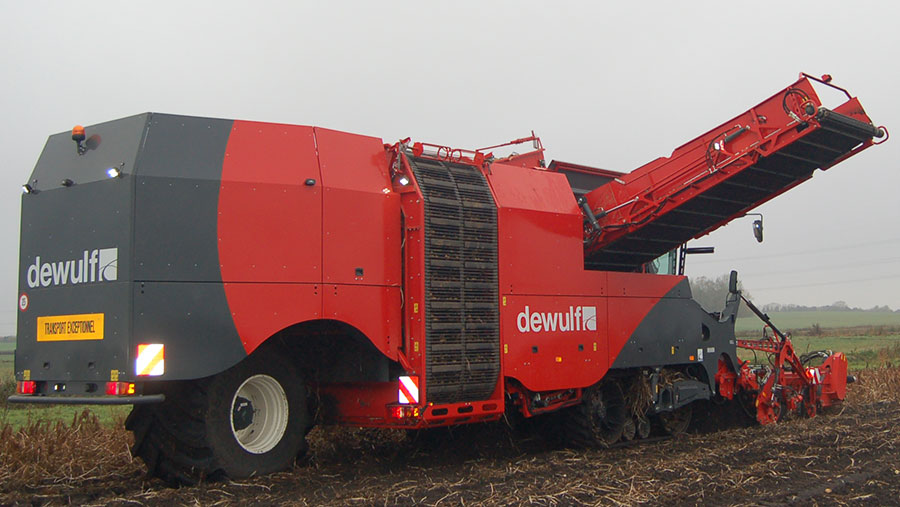Dewulf unveils giant four-row potato harvester for 2017

Belgian root crop machinery specialists Dewulf is set to unleash a giant four-row self-propelled potato harvester onto the UK market for the 2017 season.
The current sector leader is Grimme, but the German firm is facing stiff challenges from Ploeger, AVR and now Dewulf, which has been testing its new Kwatro Xtreme in the east of England this autumn.
The Kwatro was first launched in 2010, followed by a second generation in 2016 and of the 18 second release machines built, all have been earning their keep on the continent.
See also: NAAC farm contractor charges 2016-17
Wide webs
The new Kwatro Xtreme – due to be on show at Lamma and set to be launched in 2017 – is available through importer Niagri Engineering and has been revamped to tackle the UK’s traditional 90cm rows by using two 1,750mm webs side-by-side.
This gives a total web width of 3.6m all the way through to the ring elevator – a feature that Dewulf claims is an advantage over the competition.
The Kwatro Xtreme is also the only machine on the market able to lift without a wheel running through the crop and this means easier harvesting, according to Niagri, while avoiding compaction on ridges and reducing damage to crops.
The machine is fitted with Claas’ well-proven 900mm tracks, but it is the rear wheel that catches the eye. At 1,250mm it is one of the largest sizes on the market, yet does not look out of place on a machine of this size.
Innovative cleaning
A couple of clever features allow for better cleaning, with Dewulf’s Flexyclean system directing potato flow over a rubber by-pass web, suitable for dry conditions.
When things get stickier, this web moves back to allow the crop to fall onto a set of longitudinal axial rollers – the dirtier the crop, the more of the rollers are revealed.
The harvester can also be configured with additional Easyclean system at the rear of the machine, which offers further cleaning improvements in difficult conditions.
Hydraulic rams allow the operator to increase the pitch of front webs for more aggressive cleaning when needed, with the Kwatro maintaining stability by tilting left or right by 5 deg.
Grunt is supplied by a 500hp 13-litre Scania engine, which meets Tier 4 emissions regulations and sits at the rear. Dewulf claims that layout makes for a quiet cab and easy maintenance access, while a 1,000-litre fuel tank should provide sufficient liquid refreshment.
Working revs are between 1,250rpm and 1,750rpm and it tends to sit at a lower rpm than a two-row Dewulf R3060.
The revamp has pushed the dimensions out to 4.1m wide, with length a massive 14.8m, so an escort will be required on UK roads. It’s a similar story with weight – its weighs 30t unloaded and bulks up to 41t when its 11t bunker is filled.
Manoeuvrability
With these beefy dimensions turning must be a headache? Not so, according to Andrew Barwell, who has been trialling the machine and was surprised by its manoeuvrability.
The hydrostatically driven front tracks and 60-deg turning angle of the rear wheel means the machine can virtually turn within its own length. The lifting mechanism is out in front of the tracks, so can be positioned over the first 2m of rows at headlands.
Dewulf is also working on a topper that will discharge haulm to the side rather than laying it down between the rows. This will be better suited to the heavier-topped crops in the UK.
Niagri Engineering has yet to set a price for the Kwatro Xtreme, but similar harvesters are in the range of £550,000-£600,000.
The market – self-propelled spud harvesters
Farmers Weekly estimates that the number of new self-propelled machines sold per year is between 30 and 60, depending on financial conditions, and up to 20% of these will be four-row.
The number of buyers may be limited, but the reasons for investing in such a machine will be familiar – growers want to get off the land earlier to avoid poor soil conditions caused by increasingly erratic weather.
Potato growing has become increasingly specialised, with larger growers running several machines. Niagri’s Michael Gott believes that some Kwatro Xtremes will go to groups looking to take on more land, swapping three existing machines for two – a two-row and four-row Kwatro Xtreme.

